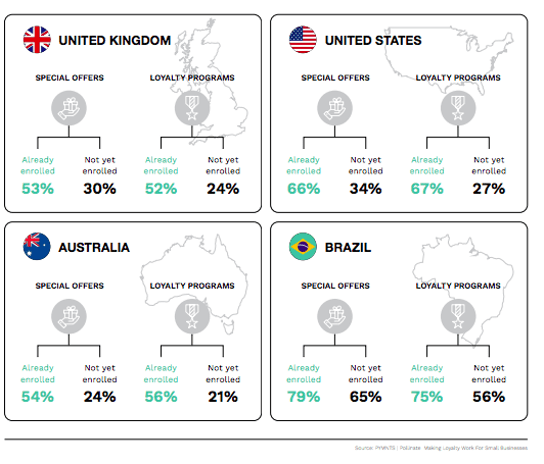SMBs And The Consumer Loyalty Challenge Worldwide

In theory, the pandemic period has done wonders to boost consumers’ connections to their local businesses worldwide. When PYMNTS, in cooperation with Pollinate, surveyed 4,519 consumers in four countries (the United States, the United Kingdom, Australia and Brazil), the data confirmed as much as 53 percent of those surveyed worldwide reported that it is more important to shop with these local businesses today than it was before the pandemic began.
But believing something is important to do and actually doing it are far from the same thing — and while a clear majority report supporting local businesses conceptually, PYMNTS’ latest research shows that in practice just 18 percent of the consumers in these four countries buy primarily from local shops, while the vast majority populate their shopping experience with mass merchants, online stores and national chain stores.

There is, quite apparently, quite a gap between consumers’ perception of how they ought to be shopping and the choices they are making when they actually shop, indicating that small and medium-sized businesses (SMBs) worldwide have a bit of a loyalty conundrum when it comes to their customers, who support them but not enough to favor them when it comes time to decide where to spend their funds.
A conundrum, according to the data, that is also a massive opportunity for local merchants that can crack the consumer loyalty puzzle.
According to the data, 57 percent of surveyed consumers (that’s 277 million shoppers in the U.S., the U.K., Australia and Brazil) expressed a desire to have access to local loyalty programs. About half of all local shoppers currently report using them, while 64 perent report a desire to — meaning, per the report, roughly 45 million shoppers are not currently using loyalty programs but could be attracted by small-town retailers that provide them.
But while one might assume the obvious solution is to run out and build more loyalty programs, the report also contains a notable caveat that consumers have limits in terms of how many loyalty programs they want to have to juggle. Of the surveyed consumers, 25 percent said there is not enough inherent value built into the program to have to keep track of it, while 13 percent reported they don’t “want to carry loyalty cards or coupons in their wallets” and 7 percent said local loyalty is too limited in its uses.
And tendency to local loyalty is highly conditioned by national origin. Australian consumers are the most likely to be using loyalty programs among those shopping primarily with local retailers, representing 67 percent of local shoppers down under. U.K. consumers come in at a close second, at 63 percent, and online shoppers in the U.K. are the most likely to use loyalty programs, with 75 percent doing so. The U.S. trails notably, with only 57 percent of consumers tapping into local loyalty programs, while Brazil represents the usage basement with only 39.5 percent leveraging local loyalty.
But those figures, the study points out may be a bit misleading and indicate more about availability than interest, particularly in Brazil where 56 percent of consumers are not using loyalty or special offer programs now, but report they are nevertheless “very” or “extremely” interested in using them. Even more would like to receive their local merchants’ special offers, as 65 percent of Brazilian consumers who are not enrolled in such programs now would be “very” or “extremely ” interested in enrolling if they were available. What that indicted, according to the report, is that there are 45 million to 52 million customers in towns across Brazil looking for loyalty programs or special offers.
Consumers in the more developed markets of the U.S., U.K. and Australia, on the other hand, are more likely to already have access to such programs than Brazilian consumers and as such express more interest in exploring other loyalty programs and specialty offer opportunities going forward.

U.S. consumers are the second-most likely to express interest in using loyalty programs and receiving special offers from local retailers, with 53 percent of U.S. consumers — 139 million people — saying they would be “very” or “extremely” interested in using loyalty programs that might be offered by local retailers. Interest in using more loyalty programs is as high as 67 percent among those who are currently enrolled in at least one type of local loyalty program, and 66 percent of consumers who are already enrolled would be interested in signing up to receive additional special offers and promotions for shopping local.
Consumers worldwide are interested in shopping locally — 45 percent report it is critical in order to reinvest in their local economies, while 44 percent say it is important to keep money in their local communities. Forty-three percent say that purchasing from local retailers is important because it can help expand local job opportunities. That shopping local is important seems to be a point of universal agreement, and while global interest in local rewards varies by jurisdiction — and host of other factors such as age and income level — the interest is present in at least over a third of consumers in every market we surveyed.
The challenge, the report demonstrates, is building out relevant rewards for local customers that don’t create friction for their users.
